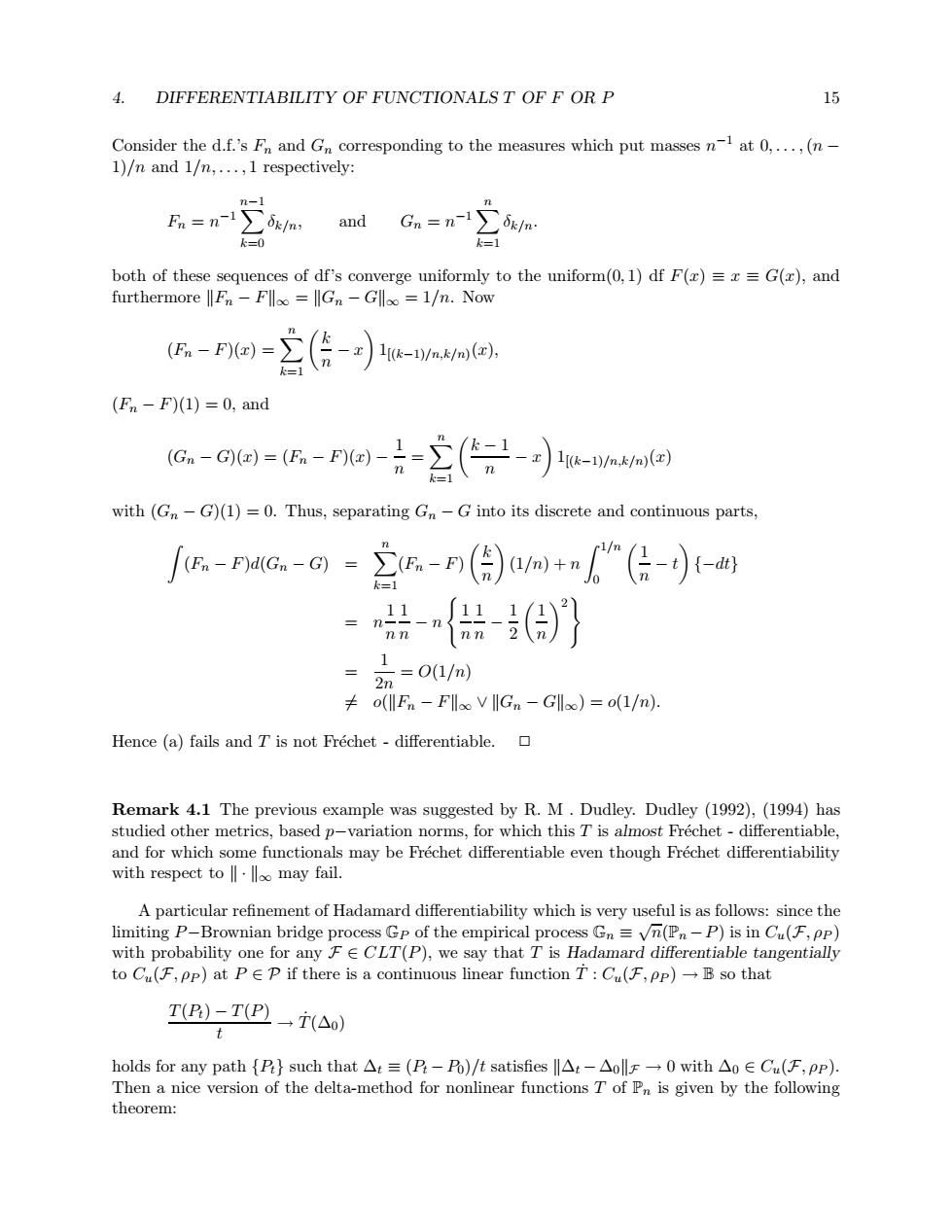正在加载图片...

4. DIFFERENTIABILITY OF FUNCTIONALS T OF F OR P 15 Consider the d.f.'s Fn and Gn corresponding to the measures which put masses n-at 0,...,(n- 1)/n and 1/n,...,1 respectively: Fn =n- and Gn=n-1∑d k=0 k=1 both of these sequences of df's converge uniformly to the uniform(0,1)df F(x)==G(x),and furthermore lFn-Flloo =Gn -Glloo 1/n.Now -P=E(信-)s-wAna, (Fn-F)(1)=0,and G-o因=-a--含(--nAw回 with (Gn-G)(1)=0.Thus,separating Gn-G into its discrete and continuous parts, fK.-aG-a=∑.-r(月)am+n(合-)- 出-供)} 1 -=O(1/m) 2n o(lFn -Flloo VIIGn -Glloo)=o(1/n). Hence (a)fails and T is not Frechet-differentiable. Remark 4.1 The previous example was suggested by R.M.Dudley.Dudley (1992),(1994)has studied other metrics,based p-variation norms,for which this T is almost Frechet -differentiable, and for which some functionals may be Frechet differentiable even though Frechet differentiability with respect to llloo may fail. A particular refinement of Hadamard differentiability which is very useful is as follows:since the limiting P-Brownian bridge process Gp of the empirical process Gn=Vn(Pn-P)is in Cu(F,Pp) with probability one for any FE CLT(P),we say that T is Hadamard differentiable tangentially to Cu(F,Pp)at PE P if there is a continuous linear function T:Cu(F,Pp)B so that T)-T(P-→T(△o) holds for any path{P}such that△t≡(P-Po)/t satisfies ll△t-△ollF→0with△o∈Cu(F,pp). Then a nice version of the delta-method for nonlinear functions T of Pn is given by the following theorem:4. DIFFERENTIABILITY OF FUNCTIONALS T OF F OR P 15 Consider the d.f.’s Fn and Gn corresponding to the measures which put masses n−1 at 0, . . . ,(n − 1)/n and 1/n, . . . , 1 respectively: Fn = n−1 n !−1 k=0 δk/n, and Gn = n−1!n k=1 δk/n. both of these sequences of df’s converge uniformly to the uniform(0, 1) df F(x) ≡ x ≡ G(x), and furthermore .Fn − F.∞ = .Gn − G.∞ = 1/n. Now (Fn − F)(x) = !n k=1 %k n − x & 1[(k−1)/n,k/n)(x), (Fn − F)(1) = 0, and (Gn − G)(x) = (Fn − F)(x) − 1 n = !n k=1 %k − 1 n − x & 1[(k−1)/n,k/n)(x) with (Gn − G)(1) = 0. Thus, separating Gn − G into its discrete and continuous parts, # (Fn − F)d(Gn − G) = !n k=1 (Fn − F) %k n & (1/n) + n # 1/n 0 % 1 n − t & {−dt} = n 1 n 1 n − n * 1 n 1 n − 1 2 % 1 n &2 + = 1 2n = O(1/n) 1= o(.Fn − F.∞ ∨ .Gn − G.∞) = o(1/n). Hence (a) fails and T is not Fr´echet - differentiable. ✷ Remark 4.1 The previous example was suggested by R. M . Dudley. Dudley (1992), (1994) has studied other metrics, based p−variation norms, for which this T is almost Fr´echet - differentiable, and for which some functionals may be Fr´echet differentiable even though Fr´echet differentiability with respect to . · .∞ may fail. A particular refinement of Hadamard differentiability which is very useful is as follows: since the limiting P−Brownian bridge process GP of the empirical process Gn ≡ √n(Pn −P) is in Cu(F, ρP ) with probability one for any F ∈ CLT(P), we say that T is Hadamard differentiable tangentially to Cu(F, ρP ) at P ∈ P if there is a continuous linear function T˙ : Cu(F, ρP ) → B so that T(Pt) − T(P) t → T˙(∆0) holds for any path {Pt} such that ∆t ≡ (Pt −P0)/t satisfies .∆t − ∆0.F → 0 with ∆0 ∈ Cu(F, ρP ). Then a nice version of the delta-method for nonlinear functions T of Pn is given by the following theorem: